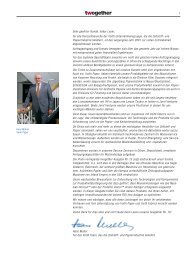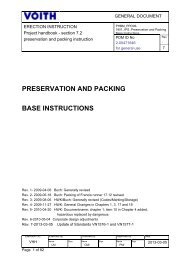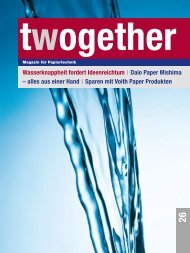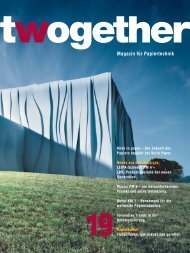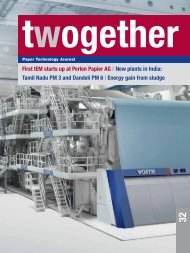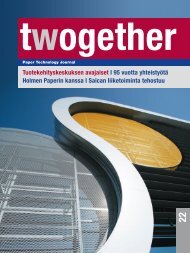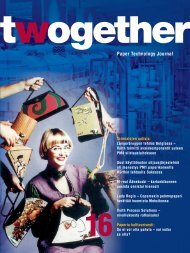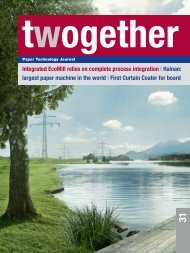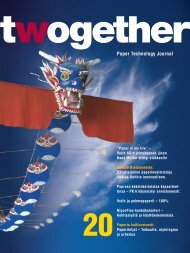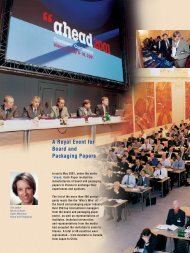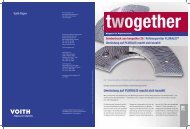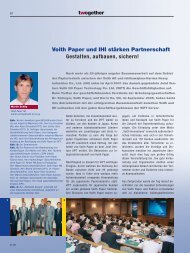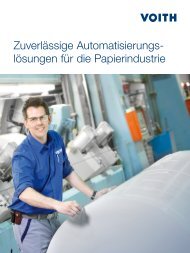Create successful ePaper yourself
Turn your PDF publications into a flip-book with our unique Google optimized e-Paper software.
30<br />
Fig. 5: Pressure profile of a conventional press<br />
nip and a TissueFlex press nip.<br />
Fig. 6: TissueFlex.<br />
5 6<br />
Pressure [MPa]<br />
ble roll cover variants from rubber to ceramic<br />
can be used as for the Nipco P<br />
Roll. The press roll is a compact unit that<br />
eliminates the bolted connection between<br />
roll head and body. A further advantage<br />
of the NipcoFlex and press roll in multiroll<br />
presses is the use of CARB Bearing<br />
<strong>Technology</strong>. In this way, efficient shoe<br />
press modules can be integrated into<br />
compact framing of the press sections. It<br />
goes without saying that press rolls can<br />
also be used in many graphic paper machines<br />
as well as in pulp dewatering.<br />
Tissue<br />
One of the latest developments is the use<br />
of shoe press technology in the production<br />
of tissue. Ten TissueFlex are currently<br />
in operation and another system will<br />
start production this year.<br />
A characteristic feature of a TissueFlex<br />
module is the flexible press sleeve and<br />
<strong>17</strong>/04<br />
3<br />
2<br />
1<br />
0<br />
0<br />
Suction press roll TissueFlex Press<br />
20 40 60 80 90 100 120<br />
Nip length [mm]<br />
the loading of this press sleeve over the<br />
concave pressure shoe. The advantages<br />
of an extended press zone permit gentle<br />
dewatering with flat pressure gradients<br />
and low max. pressures compared to<br />
conventional presses. The pressure profile<br />
in the nip can be established by the<br />
shoe contour and is particularly characterized<br />
by the steep pressure drop in the<br />
outgoing nip (Fig. 5). This is not possible<br />
with conventional rolls and permits the<br />
minimization of rewetting. Particularly in<br />
the production of tissue – where maximum<br />
specific bulk in addition to high<br />
drynesses is required – this is of great<br />
significance. The maximum linear loads<br />
depend on the loadability of the Yankee<br />
dryer and are up to 200 kN/m.<br />
To meet the special requirements of tissue<br />
production, the loading unit, the<br />
pressure shoe and the flexible QualiFlex<br />
press sleeve have been specially further<br />
developed for use with tissue. On other<br />
functional parts the well proven technology<br />
of the NipcoFlex has been taken over<br />
from packaging paper and graphic paper<br />
applications (Fig. 6). The flexibility of the<br />
pressure shoe and the type of pressure<br />
shoe loading by individually adjustable<br />
front-side and drive-side loading cylinders<br />
ensure an even moisture profile.<br />
Pulp<br />
Through the economic advantages of<br />
shoe press technology and the high drynesses,<br />
NipcoFlex Presses are increasingly<br />
used for pulp dewatering. This<br />
applies both to new machines and to the<br />
rebuild of existing installations. Due to<br />
the high linear loads required and the, in<br />
many cases, large working widths of the<br />
pulp dewatering machines, the Nipco P<br />
Roll is suitable as a backing roll for the<br />
NipcoFlex shoe roll. The Nipco P Roll<br />
(Fig. 7) unites the advantages of position-stable<br />
support with the features of a



